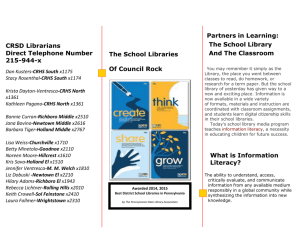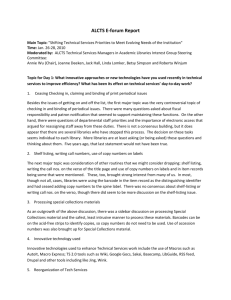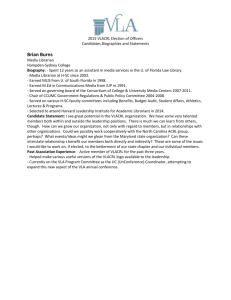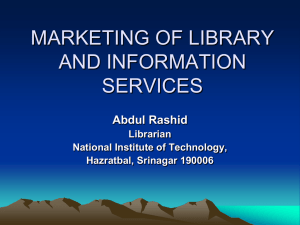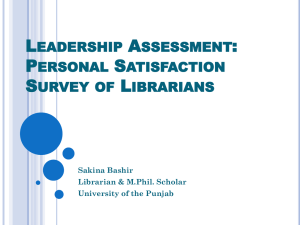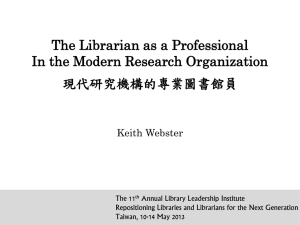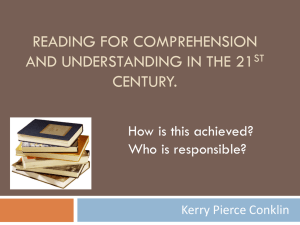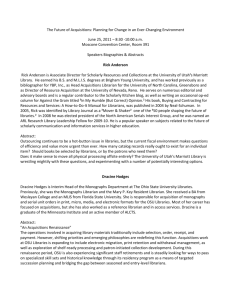New roles of librarians in web 2.0 environment
advertisement
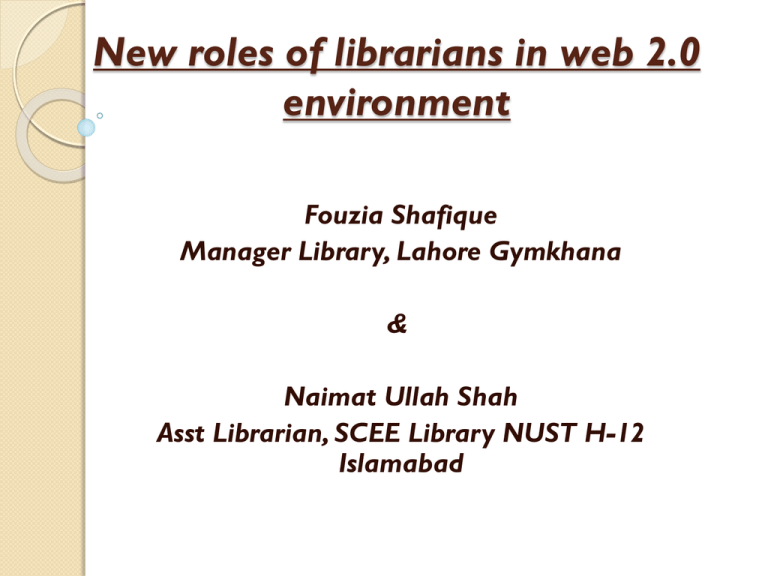
New roles of librarians in web 2.0 environment Fouzia Shafique Manager Library, Lahore Gymkhana & Naimat Ullah Shah Asst Librarian, SCEE Library NUST H-12 Islamabad Introduction: Traditionally librarians have been performing roles like Custodian- selects, organizes Print & other media Guide- assists user in searching relevant information Preserver-the books and printed documents Public Relations Officer- maintains good relationships with management, users, other libraries and organizations The New Global Library & Information Environment Geometric increase in quantity of Information. Greater and faster access to wider range of information sources via WWW. Increased speed in acquiring and disseminating information. Constantly evolving ITs(Hardware & Software) The Information World is going through transition From Library centered to Information centered From paper based environment to digital interface e.g. search engines, online databases, data mining etc. From Library as an institution to the Library as an information provider with IT skilled specialists Introduction: The information revolution and internet based information has made it difficult to select relevant information in no time, the role of the librarian is not to wait for the client to reach him/ her, but instead he should himself extend his help apart from constraints of time, place and format. Web 2.0 Tim O’ Reilly in 2004 invented and defined: “Web 2.0 is the business revolution in the computer industry caused by the move to the internet as platform, and an attempt to understand the rules for success on that new platform. Chief among those rules is this: Build applications that harness network effects to get better the more people use them”. Library 2.0 Library 2.0 is a “very different library service that operates according to the expectations of today's users. In this vision, the library makes information available wherever and whenever the user requires it” Realizing this vision requires change across a wide range of systems, processes and attitudes. Principles of Library 2.0 Library is everywhere Library had no barriers Library invites participation New Role of Librarian in Web 2.0 environment The main roles of librarian in new era which is mainly a digital era are as: search intermediary knowledge Manager Educator- (End user trainer) Researcher Website builder/ publisher - (designs & evaluate) Facilitator- (makes access easier ) Interface Designer Knowledge sifter / selector/ evaluator Objectives To fine out: The importance of features/ characteristics of Web 2.0 in the view of professionals. The new roles of the librarian in Web 2.0 environment. To what extent are Web 2.0 technologies prevalent in University libraries Explore the attitude of professionals towards the use of Web 2.0 Statement of the problem In Pakistan this tendency is bit new but still encouraging because many libraries are adopting these technological trends. This study points out, how much important is Web 2.0 among the information professionals? Has the librarian got new roles along with the traditional ones? What is the significance of using Web 2.0 tools? Research Design and Methodology The study was quantitative A questionnaire was developed, for data collection Thirty university libraries professionals using ICT and web 2.0 technologies were surveyed. (15 from Islamabad and 15 from Lahore) SPSS 19.0 (Statistical Package for the Social Sciences) was used to carry out the results of the collected data. Results and Analysis of data The results are as under:Gender: According to the data collected, out of 27 participants 18 (70%) were male and 9 (30%) were female. Job Experience: Most of the participants were very experienced having experience of more than 9 years which is 52%, having more than 4 years and less than 8 years are 30% and only 18 % of the participants have experience of 1- 3 years Results cont…….. How important is web 2.0 Frequency Percent Valid Percent Cumulative Percent Very important 20 74.1 74.1 74.1 Important 7 25.9 25.9 100.0 Total 27 100.0 100.0 How important is Library 2.0 When asked about the importance of Library 2.0, 18 participants ticked the very important option and other 9 selected important, but nobody denied its importance Results cont….. Questions relating to importance of several tools of Web 2.0 like: Content sharing Blogs Wikis RSS Social networks Tagging 55% of total participants marked that these tools very important, 18 % marked these as important. Results cont…….. Questions relating to some characteristics of Web 2.0 are answered as: Library is every where: strongly agree Agree Neutral Total • Frequency Percent 13 9 5 27 48.1 33.3 18.5 100.0 Library invites sharing and interaction: Frequency Percent strongly agree Agree 14 11 51.9 40.7 Neutral 2 7.4 Total 27 100.0 Like web 2.0 there is also library 2.0 Frequency strongly agree Agree Neutral Total 9 12 6 27 Percent 33.3 44.4 22.2 100.0 Digital collections are shared strongly agree Agree Neutral Disagree Total Frequency 11 10 3 3 27 Percent 40.7 37.0 11.1 11.1 100.0 Cont….. Librarians are information broker (Print & digital Media) strongly agree Agree Neutral) Total Frequency Percent 33.3 59.3 7.4 100.0 9 16 2 27 Librarians are interactive & collaborate Frequency strongly agree Agree Neutral Total 9 12 6 27 Percent 33.3 44.4 22.2 100.0 Cont….. Librarians are facilitators strongly agree Agree Neutral Total Frequency Percent 17 63.0 7 25.9 3 11.1 27 100.0 Librarians are educators and trainers strongly agree Agree Disagree Total Frequency Percent 3 11.1 22 81.5 2 7.4 27 100.0 Conclusion. With these drastic developments in ICT and in large use of Web 2.0, the role of the librarian does not remain as simple as it used to be, for example custodian of books and book keeper, as he now performs different roles and is known with these new titles: information specialist, information navigator, information professional global information provider, Innovators, websites designers, educators, trainers, information broker (Print & digital Media), the concept of library without walls is truly and completely adopted due to web 2.0, and libraries have become library 2.0. References Casey, M. (2005). Working towards a definition of Library 2.0. Library Crunch: bringing you a library, 2.0 Cohen, L. (2006). A librarian's 2.0 manifesto. Message posted to http://liblogs. albany. edu/library20/2006/11/a_librarians_20_manifesto. html. Gutsche, B., Lenox, M., Houghton-Jan, S., & Iaukea, E. (2010). Competencies for libraries. Ingwersen, P. (1992). Information and information science in context. Libri, 42(2), 99135. Kim, S. (1999). The roles of knowledge professionals for knowledge management: Citeseer. King, S., & Cotterill, S. (2007). Transformational government? The role of information technology in delivering citizen-centric local public services. Local Government Studies, 33(3), 333-354. Mairaj, M. I., & El-Hadi, W. M. (2012). The Impact of the Internet and Mobile Phones on Family Relations in Pakistan. Intergenerational solidarity in libraries/La solidarité intergénérationnelle dans les bibliothèques, 156, 309. Maness, J. M. (2006). Library 2.0 theory: Web 2.0 and its implications for libraries. Webology, 3(2), 2006. Peltier-Davis, C. (2009). Web 2.0, Library 2.0, Library User 2.0, Librarian 2.0: Innovative Services for Sustainable Libraries. Computers in Libraries, 29(10), 16-21. Rao, K. N., & Babu, K. (2001). Role of librarian in Internet and World Wide Web environment. Informing Science, 4(1), 25-34. Stephens, M., & TechSource, A. (2006). Web 2.0 & libraries: Best practices for social software: ALA TechSource. Thank You
